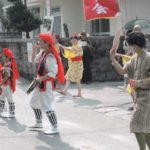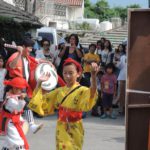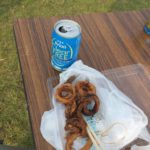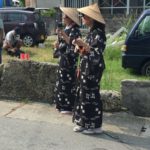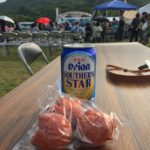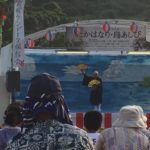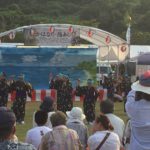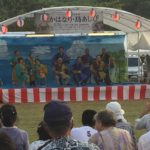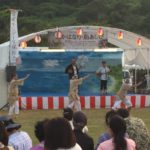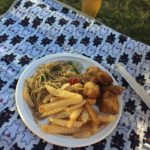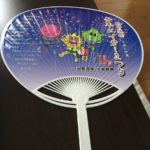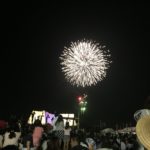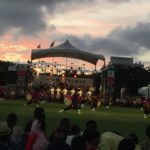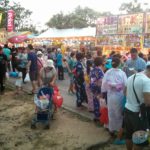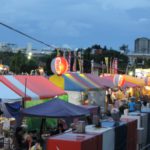One of the most popular natsu matsuri (summer festival) 夏祭り is the All-island Okinawa Eisa and Orion beer festival held the weekend following obon— at least with Americans that is. Held at the Koza Sports Park, I have seen more Americans at this festival than any other. It is actually 2 festivals, coinciding with each other: the eisa festival itself and the Orion Beer Festival.
*In 2018, this will August 31-September 2.
To reach the festival, there are free shuttle buses, as there is no parking at the venue. You can park at Aeon Rycom Mall, as well as some other areas to catch the free shuttle buses. Otherwise, there are some paid parking areas near Koza.
On Friday evening, in the Koza area, there is the Eisa parade. The parade is actually pretty nice; bring a leisure sheet to sit on and some dinner to relax and watch. Next to us, there was a family with a kid (who could not have been more than 3 or so) and he played his pint size drum, dancing around in his eisa outfit as the groups played on the street. He was quite entertaining.
On Saturday and Sunday, is the actual eisa festival and beer festival; the festivals, though both are at the Koza Sports Park, is divided into 2 sections. On one side is the Orion Beer festival, with outdoor tables and chairs, music stage entertainment, Orion Beer girls, tents selling nothing but Orion draft beer, and of course, loud drunk Americans (well, and locals too, if we are being honest). When you enter, they give you a wristband if you are of drinking age and you MUST have it to buy alcohol. I usually don’t spend more than about 5 minutes there, as it really isn’t my scene. But I think the beer is usually cheaper on this side than the eisa festival side, so…
The other side where the eisa festival is, however, more family friendly. There are pay seats in the bleachers, but for free you can just bring a sheet and sit in the field to watch. It is all eisa performances, so it can get a bit repetitive, but can be a fun evening out, especially if you have never been to a natsu matsuri before. You will likely see many girls (both local and foreign) wearing summer yukata or jinbei.
Of course, lining the entire area is typical summer festival food tents. A lot of these are what I refer to as generic “yellow tent” food (due to a majority of them using a basic yellow tent), a company that comes in and sells mediocre food in large volume.. often times it is not really hot when you get it. I try to find the more local vendors, who are usually hawking piping-hot fresh food. Over here, you can still buy beer and are away from the drunk scene.
At the end of the night, there are fireworks to finish off the evening. While it is not my favorite festival on island it can still be fun, especially for new-comers, and you can experience a lot of eisa all in one place. Plus, I have to admit, all the lanterns strung up with happy festival goers in yukata, drums and fireworks gives a nice ambience on a hot summer evening.
address: Koza Sports Park, https://goo.gl/maps/qXA6QUxsdyT2
official festival website: https://www.zentoeisa.com/
